
Wine Culture and Information since 2002 - Volume 22
 Wine Culture and Information since 2002 - Volume 22 |
|
Comparing Barbera d'Asti Superiore and Barbera d'AlbaBarbera is one of the most cultivated and common grapes of Piedmont. Asti and Alba the two main areas in which this famous red berried grape expresses its best qualities |
|
Barbera is one of the many grapes of Piedmont which are getting more and more popular among wine lovers for its quality. Among the most common and cultivated varieties in Piedmont, Barbera has represented in past years the most known red wine of this region, most of the times associated to ordinary wines, one of those produced in great quantity without caring too much about quality. As it frequently happens, in respect of the happiest tradition of tales, Cinderella meets her prince and, like a magic, she becomes a princess. In case of Barbera we should better talk about many princes, as its success it is - as a matter of fact - the consequence of stubbornness and commitment of many Piedmontese vintners, in particular in the area of Asti and Alba. Today Barbera is considered among the great red berried grapes of Piedmont and Italy, highly regarded by wine lovers, it is a truly versatile grape, capable of making “lively” wines - of joyous effervescence - as well as austere and full bodied wines.
|
Barbera d'Asti, as well as Barbera del Monferrato Superiore - according to the Italian quality system - represent the highest expression of this grape, as the wines produced in this area belong since 2008 to the DOCG rank, Denominazione d'Origine Controllata e Garantita (Denomination of Controlled and Guaranteed Origin). The production disciplinary provides for many styles and three subareas. It should be said there is a difference between the classico and superiore style, also reminding this wine can be produced with at least 85% of Barbera and the remaining part can be represented by Freisa, Grignolino and Dolcetto grapes, also blended together. The classico style must have a minimum alcohol by volume of 12% and the aging must be of at least 4 months, a procedure which can also be done in wood. Barbera d'Asti Superiore requires a minimum alcohol by volume of 12.50% and a minimum aging period of 14 months, of which at least 6 in oak of chestnut casks. Production disciplinary of Barbera d'Asti also provides for the definition of the three subareas Nizza, Tinella and Colli Astiani, to be mentioned in the label. Of them, the subarea which is getting the highest appreciation and notoriety certainly is Nizza. Despite the production disciplinary provides for the use of the grapes Freisa, Grignolino and Dolcetto, there are many producers who prefer using 100% Barbera. This choice is mainly determined by the will of producers who are trying to increase the value of Barbera - in particular in the Nizza subarea - a grape having evident qualities to make great wines, something proven in the past years. Barbera d'Asti is currently produced - according to the production disciplinary - in 118 communes in the province of Asti and in 51 in the province of Alessandria. Thanks to the versatility of this grape, producers make many styles and interpretations. There are in fact styles which are more fresh and immediate, completely vinified in inert containers, as well as robust and austere styles, fermented and aged in cask or barrique. It is hard to tell the best way to vinify Barbera as, thanks to its versatility, it can be gotten interesting results both in the vinification in steel tanks as well as in cask. It should also be said styles vinified in barrique usually get a higher appreciation, in particular in foreign countries, more apt to the so called international style.
|
||||||||
|
Barbera is very common in the Langhe area and in the territory of Alba, areas mainly known for the wines produced with Nebbiolo grape. Nevertheless, also in the territory of Alba are produced Barbera wines of high quality, a sign the grape has found its best place in the region: it is not by chance Barbera is the most common variety in Piedmont. As opposed to Barbera d'Asti, the production disciplinary of Barbera d'Alba - a wine ranked as DOC, Denominazione d'Origine Controllata (Denomination of Controlled Origin) - provides for the exclusive use of Barbera grape. Production disciplinary for Barbera d'Alba provides for a minimum alcohol by volume of 12% and does not specify a minimum period of aging, therefore leaving this choice to producers. In case alcohol by volume is at least 12.5% and wine is aged in oak or chestnut cask for at least 12 months, the wine can be ranked as “superiore” (superior). It should be noticed many producers - also in case their wines have these characteristics, that is at least 12.5% alcohol by volume and aged in wood for at least one year - they do not mention in the label of their wines the indication “superiore”. It should also be said most of Barbera d'Alba is aged in wood casks, sometimes the barrique, therefore giving the wine a higher structure as well as rounding the typical acidity and harshness of the grape. Despite the production disciplinary takes its name from the city of Alba, the wine is produced in a territory of 54 communes in the province of Cuneo, where at the center is located the city of Alba. Barbera is a late riping grape, and this is perfectly scheduled in the viticultural calendar of Langhe. The grape reach its ripeness at the end of September or the beginning of October, a period preceding the harvesting of Nebbiolo and following the one of Dolcetto. The yield in vineyard is defined - according to the production disciplinary - to a maximum of 100 quintals per hectare, however quality productions halve this measure. Barbera is in fact a grape usually producing high quantity of grapes, therefore it is indispensable a proper work in the vineyard in order to limit production, an essential condition for making quality wines.
|
||||
|
This month's comparative tasting will examine two wines having pretty similar characteristics, of course produced in different areas. Both wines are in fact produced with 100% Barbera and aged in barrique for at least one year. Also the alcohol by volume is the same in both cases: 14%. The first wine of our comparative tasting is Marchesi Alfieri's Barbera d'Asti Superiore Alfiera, aged in barrique for 12 months and at least 8 in bottle. The second wine is Monchiero Carbone's Barbera d'Alba MonBirone, aged for about 15 months in barrique and for at least 9 in bottle. It should be said the vintage currently available for Marchesi Alfieri's Barbera d'Asti Superiore Alfiera is 2006, a vintage for which the DOCG status was not issued yet, it is therefore a DOC wine. The wines will be tasted at a temperature of 18°C (65°F), in order to better appreciate the roundness of wine - although expressing the rustic and crisp character of the grape - and served in two ISO tasting glasses.
|
|
Barbera is a grape having a pretty high coloring quality. The quantity of coloring substances found in the skin give in fact the wine pretty intense and deep colors, as well as a pretty low transparency, sometimes impenetrable to light. These qualities of course depend on viticultural presuppositions. Barbera is a variety tending to overproduction, therefore in case are not adopted proper measures in order to low production, that is, factors of quality viticulture, wines tend to have a less intense color and more specifically, a higher transparency. Wines produced with Barbera are frequently characterized in youth by evident purple red nuances, frequent qualities in wines aged in inert containers. The aging in wood tends to oxidize the coloring substances of wine, therefore in these wines, also in their youth, purple nuances are pretty rare. Both in Barbera d'Asti Superiore and Barbera d'Alba, the color which can be observed is intense and brilliant, with a pretty low transparency. With time - following the normal evolution of red wines - it will be observed ruby and garnet red colors, hues which can also be observed in the nuance. The first wine of which we will evaluate appearance is Marchesi Alfieri's Barbera d'Asti Superiore. By holding the glass tilted over a white surface - a sheet of paper is enough - let's observe the wine at the base of the glass, where it can be appreciated an intense and deep ruby red color, as well as a very low transparency, confirming the good coloring quality of Barbera. By observing the edge of the wine, towards the opening of the glass, where the wine has the lowest thickness, we will observe a ruby red color, sign of the young age of the wine, that is, it has good possibilities for evolving in the next years. Let's now pass to the evaluation of Monchiero Carbone's Barbera d'Alba MonBirone. By holding the glass tilted over the white surface, we will observe at the base of the glass an intense and deep ruby red color, not so different from the previous wine, with a pretty low transparency, also in this case confirming the good coloring qualities of Barbera grape. The nuance of this wine confirms what has been observed at the base of the glass, that is an intense ruby red color.
|
|
Barbera is always generous to the nose, in particular for its exuberant aromas of red and black berried fruit, as well as flowers. The aging in wood give complexity to the wine - of course - by enriching it with tertiary aromas. Besides wood, Barbera is an explosion of fruits, in particular cherry, plum and blackberry, as well as raspberry and blueberry, whereas the most typical flower sensation is violet. Like already said, the aging in wood - which in Barbera is represented by cask as well as the more modern and smaller barrique - enriches the wine with spicy and complex aromas, such as vanilla, cocoa, chocolate, tobacco, cinnamon and sometimes black pepper, as well as pleasing balsamic sensations, frequently recalling menthol. With time and with the development of aging, also in bottle, in wines produced with Barbera grape sensations of fruits evolve in aromas of jams. Also the more complex aromatic qualities continue their evolution, frequently developing aromas of leather and tar. Let's start the evaluation of aromas from Marchesi Alfieri's Barbera d'Asti Superiore Alfiera. By holding the glass in vertical position and without swirling, let's do the first smell, procedure allowing the appreciation of the so called opening aromas, made from light aromatic substances requiring a small quantity of oxygen to volatilize. From the glass will be perceived intense, clean and pleasing aromas of cherry, plum and violet: three typical qualities of the opening in Barbera wines. After having swirled the glass, let's proceed with the second smell which will complete the profile of the wine with blueberry, blackberry, raspberry, cinnamon, chocolate, vanilla - a clear sign of the passage in wood - tobacco, pink pepper and a pleasing balsamic sensation of menthol. Let's now pass to Monchiero Carbone's Barbera d'Alba MonBirone. The opening aromas express cherry, plum and blackberry, as well as a pleasing and intense aroma of violet. After having swirled the glass, the wine completes its olfactory profile with blueberry, raspberry, vanilla, tobacco, licorice, chocolate, cinnamon, black pepper as well as a pleasing balsamic sensation of menthol.
|
|
Barbera is a grape making wines usually considered as rustic. This characteristic mainly derives from the evident acidity of the grape, therefore making pretty harsh wines. As the astringency is not very high, Barbera is usually aged in wood containers - cask or barrique - in order to give “round” tannins and to balance the evident acidity of the grape. The practice of aging in wood is more frequent in Barbera d'Alba than in Barbera d'Asti, area in which the grape is sometimes vinified in inert containers, generally steel tanks. The content in sugar is very good, quality which gives the wine a pretty high quantity of alcohol. It is not rare to find Barbera wines with an alcohol by volume higher than 14%. The main quality which can be perceived in Barbera wines clearly is acidity, a characteristic moving balance towards “hard” tones. For this reason both alcohol and aging in wood contribute to the reaching of balance, therefore making the wine rounder. Let's start the gustatory evaluation from Marchesi Alfieri's Barbera d'Asti Superiore Alfiera. The attack of this Barbera is characterized by the astringency caused by wood tannins, to which is added the evident crispness produced by acidity. These sensations are however balanced by the round and burning effect of alcohol, as well as the roundness given by the aging in barrique. It should also be noticed the structure of the wine: a full and robust body. Let's now pass to the gustatory evaluation of Monchiero Carbone's Barbera d'Alba MonBirone. The attack of this second Barbera is not so different from the previous one: also in this case can be perceived the astringency of tannins to which it is added the typical crispness of the grape. These qualities are therefore balanced both by the effect of alcohol as well as the roundness given by the aging in barrique, more evident than the previous wine. Also in this Barbera is perceived a full and robust body. The final phases of the tasting reveal in both wines a very long persistence, leaving in the mouth long, pleasing and pleasing flavors of cherry, plum and blackberry, as well as a pleasing sensation of crispness: the most typical characteristic in wines produced with Barbera.
|
Wines of the Month |
|
|
|
Score legend Prices are to be considered as indicative. Prices may vary according to the country or the shop where wines are bought |
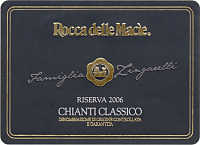
|
|
Chianti Classico Riserva 2006 |
|
| Rocca delle Macie (Tuscany, Italy) | |
| Grapes: Sangiovese (90%), Cabernet Sauvignon (5%), Merlot (5%) | |
| Price: € 19.00 | Score: |
| This Chianti Classico Riserva shows a brilliant ruby red color and nuances of garnet red, moderate transparency. The nose reveals intense, clean, pleasing and refined aromas which start with hints of black cherry, plum and violet followed by aromas of black currant, blueberry, raspberry, blackberry, vanilla, chocolate and cinnamon. The mouth has good correspondence to the nose, a tannic attack and however balanced by alcohol, good body, intense flavors, agreeable. The finish is persistent with flavors of black cherry, plum and black currant. This Chianti Classico Riserva ages for at least 2 years in cask. | |
| Food Match: Broiled meat and barbecue, Roasted meat, Stewed and braised meat with mushrooms | |
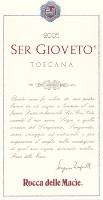
|
|
Ser Gioveto 2005 |
|
| Rocca delle Macie (Tuscany, Italy) | |
| Grapes: Sangiovese (80%), Cabernet Sauvignon, Merlot (20%) | |
| Price: € 36.00 | Score: |
| Ser Gioveto shows an intense ruby red color and nuances of garnet red, little transparency. The nose reveals intense, clean, pleasing and refined aromas that start with hints of plum, black cherry and black currant followed by aromas of dried violet, blueberry, vanilla, tobacco, leather, mace, chocolate and menthol. The mouth has good correspondence to the nose, a tannic attack and however balanced by alcohol, good body, intense flavors, pleasing roundness. The finish is persistent with flavors of plum, black cherry and black currant. Ser Gioveto ages for 14 months in barrique followed by 9 months of aging in bottle. | |
| Food Match: Roasted meat, Braised and stewed meat, Hard cheese | |
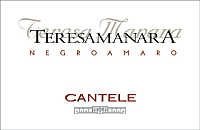
|
|
Teresa Manara Negroamaro 2007 |
|
| Cantele (Apulia, Italy) | |
| Grapes: Negroamaro | |
| Price: € 13.00 | Score: |
| Teresa Manara Negroamaro shows an intense ruby red color and nuances of ruby red, little transparency. The nose reveals intense, clean, pleasing and refined aromas which start with hints of plum, blackberry and violet followed by aromas of black cherry, blueberry, vanilla, tobacco, cocoa, mace and menthol. The mouth has good correspondence to the nose, a tannic attack and however balanced by alcohol, good body, intense flavors, pleasing roundness. The finish is persistent with flavors of plum, blackberry and black cherry. Teresa Manara Negroamaro ages for 12 months in barrique. | |
| Food Match: Roasted meat, Stewed and braised meat, Hard cheese | |
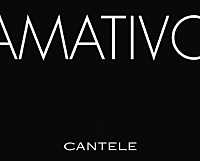
|
|
Amativo 2007 |
|
| Cantele (Apulia, Italy) | |
| Grapes: Primitivo (60%), Negroamaro (40%) | |
| Price: € 16.00 | Score: |
| Amativo shows a brilliant ruby red color and nuances of ruby red, little transparency. The nose reveals intense, clean, pleasing and refined aromas which start with hints of black cherry, blackberry and plum followed by aromas of violet, blueberry, vanilla, tobacco, cinnamon, cocoa and menthol. The mouth has good correspondence to the nose, a tannic attack and however balanced by alcohol, good body, intense flavors, pleasing roundness. The finish is persistent with flavors of plum, blackberry and black cherry. Amativo ages for 10 months in barrique. | |
| Food Match: Roasted meat, Stewed and braised meat, Hard cheese | |
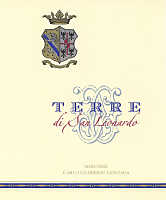
|
|
Terre di San Leonardo 2005 |
|
| Tenuta San Leonardo (Trentino, Italy) | |
| Grapes: n.d. | |
| Price: € 12.00 | Score: |
| Terre di San Leonardo shows an intense ruby red color and nuances of garnet red, moderate transparency. The nose denotes intense, clean, pleasing and refined aromas which start with hints of black cherry, black currant and plum followed by aromas of blueberry, vanilla, tobacco, chocolate and eucalyptus. The mouth has good correspondence to the nose, a moderate tannic attack and however balanced by alcohol, good body, intense flavors, pleasing roundness. The finish is persistent with flavors of black cherry, black currant and plum. A part of Terre di San Leonardo ages for 18 months in cask and the remaining part for 6 months in barrique. The wine ages for 6 months in bottle. | |
| Food Match: Stuffed pasta, Sauteed meat Broiled meat and barbecue | |
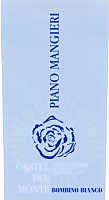
|
|
Castel del Monte Bombino Bianco Piano Mangieri 2008 |
|
| Terranostra (Apulia, Italy) | |
| Grapes: Bombino Bianco | |
| Price: € 6.00 | Score: |
| Castel del Monte Bombino Bianco Piano Mangieri shows a pale straw yellow color and nuances of greenish yellow, very transparent. The nose denotes intense, clean and pleasing aromas which start with hints of apple, plum and hawthorn followed by aromas of citrus fruits, pear and almond. The mouth has good correspondence to the nose, a crisp attack and however balanced by alcohol, good body, intense flavors, pleasing roundness. The finish is pretty persistent with flavors of apple, plum and pear. Castel del Monte Bombino Bianco Piano Mangieri ages in steel tanks. | |
| Food Match: Vegetable appetizers, Dairy products, Risotto with vegetables, Sauteed crustaceans | |
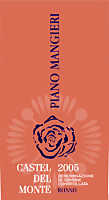
|
|
Castel del Monte Rosso Nero di Troia Piano Mangieri 2008 |
|
| Terranostra (Apulia, Italy) | |
| Grapes: Nero di Troia | |
| Price: € 7.50 | Score: |
| Castel del Monte Rosso Nero di Troia Piano Mangieri shows an intense ruby red color and nuances of ruby red, little transparency. The nose denotes intense, clean, pleasing and refined aromas which start with hints of blackberry, plum and black cherry followed by aromas of violet, tobacco, carob and menthol. The mouth has good correspondence to the nose, a tannic attack and however balanced by alcohol, good body, intense flavors, pleasing roundness. The finish is persistent with flavors of blackberry, plum and black cherry. Castel del Monte Rosso Nero di Troia Piano Mangieri ages in steel tanks. | |
| Food Match: Broiled meat and barbecue, Roasted meat, Stewed meat | |
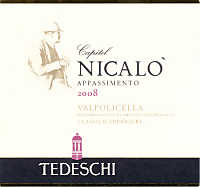
|
|
Valpolicella Superiore Ripasso Capitel San Rocco 2007 |
|
| Tedeschi (Veneto, Italy) | |
| Grapes: Corvina (30%), Corvinone (30%), Rondinella (30%), Rossignola, Oseleta, Negrara, Dindarella (10%) | |
| Price: € 14.00 | Score: |
| Valpolicella Classico Ripasso Capitel San Rocco shows an intense ruby red color and nuances of garnet red, moderate transparency. The nose denotes intense, clean, pleasing and refined aromas that start with hints of black cherry, blackberry and plum followed by aromas of dried violet, blueberry, cocoa, vanilla, tobacco and menthol. The mouth has good correspondence to the nose, a tannic attack and however balanced by alcohol, good body, intense flavors, pleasing roundness. The finish is persistent with flavors of blackberry, black cherry and plum. Valpolicella Classico Ripasso Capitel San Rocco ages for about 2 years in cask followed by 6 months of aging in bottle. | |
| Food Match: Roasted meat, Braised and stewed meat with mushrooms, Hard cheese | |
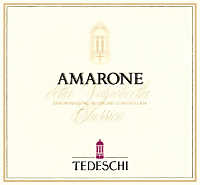
|
|
Amarone della Valpolicella Classico 2006 |
|
| Tedeschi (Veneto, Italy) | |
| Grapes: Corvina (30%), Corvinone (30%), Rondinella (30%), Oseleta, Negrara, Dindarella, Rossignola (10%) | |
| Price: € 30.00 | Score: |
| Amarone della Valpolicella Classico shows an intense ruby red color and nuances of garnet red, little transparency. The nose reveals intense, clean, pleasing and refined aromas that start with hints of blackberry, black cherry and violet followed by aromas of plum, blueberry, tobacco, vanilla, cocoa, mace, leather and menthol. The mouth has good correspondence to the nose, a tannic attack and however balanced by alcohol, full body, intense flavors, pleasing roundness. The finish is persistent with flavors of blackberry, black cherry and plum. Amarone della Valpolicella Classico ages in cask for 3 years followed by 6 months of aging in bottle. | |
| Food Match: Game, Stewed and braised meat, Roasted meat, Hard cheese | |
|
||||||||
|
DiWineTaste Polls
|
| |||||||
Privacy Policy | |||||||


| Copyright © 2002-2024 Antonello Biancalana, DiWineTaste - All rights reserved |
| All rights reserved under international copyright conventions. No part of this publication and of this WEB site may be
reproduced or utilized in any form or by any means, electronic or mechanical, without permission in writing from DiWineTaste. |